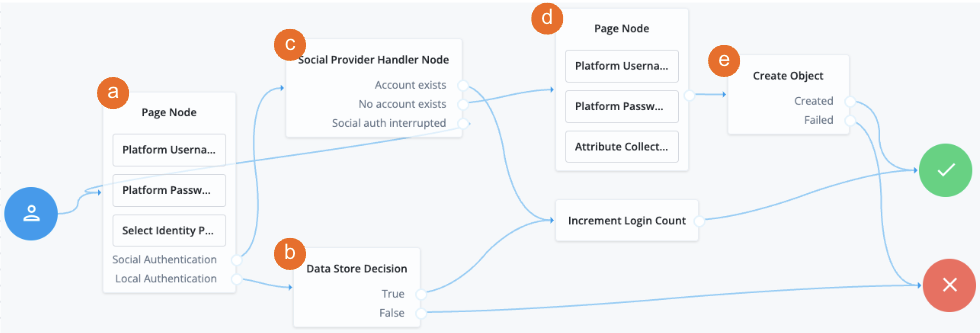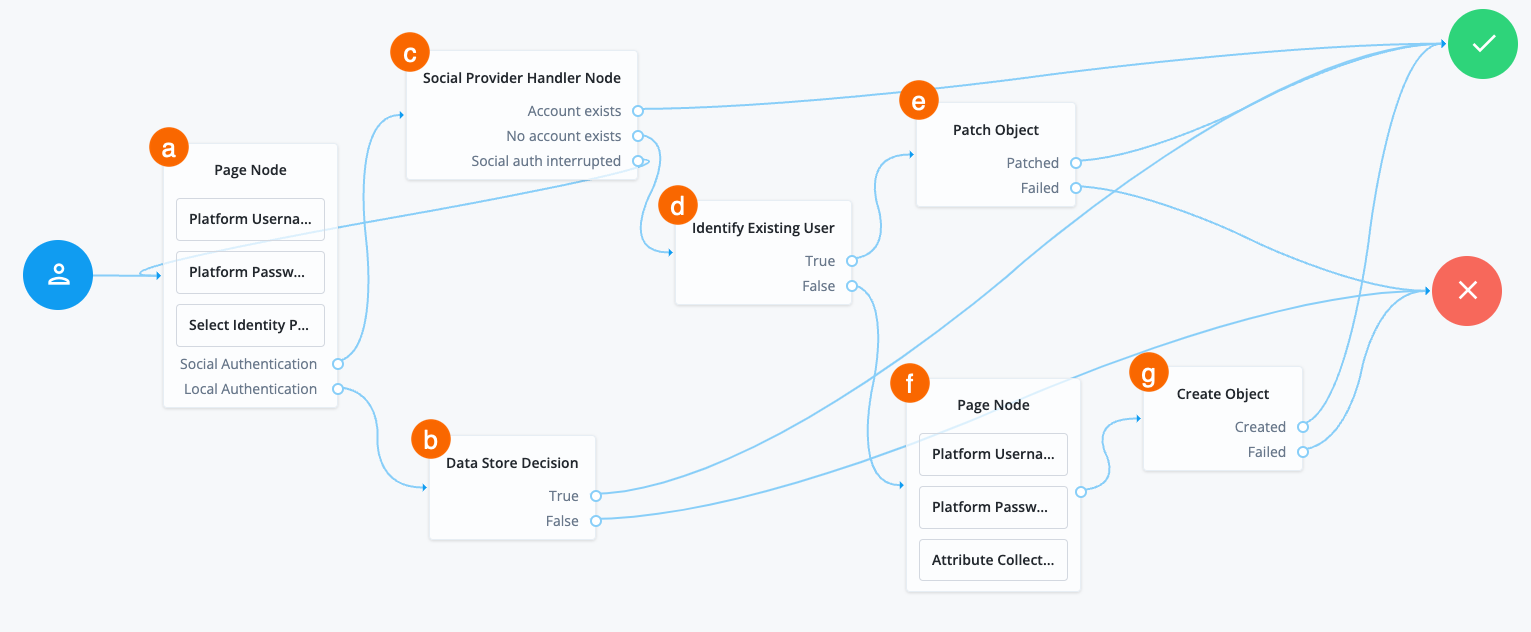Select Identity Provider node
The Select Identity Provider node presents an end user with a list of configured, enabled, social identity providers to use for authentication.
Use this node with the Social Provider Handler node for social authentication.
|
You can configure this node to show only the identity providers the user has already associated with their account. This is useful, for example, in account claiming flows, where a user wants to associate a new social identity provider with an account that’s being authenticated through social authentication. In cases such as account claiming, where the user has already authenticated once and is linking a new identity provider,
the node only displays a local sign-in option if it detects that the user’s account has a |
Examples
Example 1: Social authentication
This example shows the Social Provider Handler and Select Identity Provider nodes in a social authentication journey.

a The Page node containing the Select Identity Provider node prompts the user to select a social identity provider or to authenticate with a username and password.
b If the user selects local authentication, the Data Store Decision node takes care of the authentication.
c If the user selects social authentication, the Social Provider Handler node does the following:
-
Routes the user to the selected social provider to authenticate there
-
Retrieves the user’s profile information, and transforms it into a format that Advanced Identity Cloud can use
-
Assesses whether the user has an existing user account in Advanced Identity Cloud
-
If the user has an existing user account, authenticates that user
-
If the user doesn’t have a user account, routes the user to another page node
-
If the user interrupts the social authentication, routes the user back to the Select Identity Provider node
-
d The nodes on the page node request the information required to register a new user account.
e The Create Object node creates the new user account in Advanced Identity Cloud.
Example 2: Dynamic account linking
This example shows a social authentication journey with dynamic account linking.

a A Page node contains the Select Identity Provider node node that prompts the user to select a social identity provider or to authenticate with a username and password.
b If the user selects local authentication, the Data Store Decision node takes care of the authentication.
c If the user selects social authentication, the Social Provider Handler node does the following:
-
Routes the user to the selected social provider to authenticate there
-
Retrieves the user’s profile information, and transforms it into a format that Advanced Identity Cloud can use
-
Assesses whether the user has an existing user account in Advanced Identity Cloud
-
If the user has an existing user account, authenticates that user
-
If the user doesn’t have a user account, routes the user to the Identify Existing User node
-
If the user interrupts the social authentication, routes the user back to the Select Identity Provider node
-
d The Identify Existing User node checks if the user exists in Advanced Identity Cloud using the Identity Attribute specified and does the following:
-
If the user exists, routes the user to the Patch Object node
-
If the user doesn’t exist, routes the user to another page node
e The Patch Object node updates the existing user to create the link.
f The nodes on the page node request the information required to register a new user account.
g The Create Object node creates the new user account in Advanced Identity Cloud.
Availability
| Product | Available? |
|---|---|
PingOne Advanced Identity Cloud |
Yes |
PingAM (self-managed) |
Yes |
Ping Identity Platform (self-managed) |
Yes |
Inputs
The node reads the username and password from shared state.
Implement a Platform Username node and a Platform Password node earlier in the journey.
Dependencies
The Social Identity Provider service must be configured with the details of at least one social identity provider.
Find more information on this service in Social Identity Provider Service.
Configuration
| Property | Usage | ||
|---|---|---|---|
Include local authentication |
Whether local authentication is included as a method for authenticating. |
||
Offer only existing providers |
When enabled, the node limits the social identity provider choices to those already associated with the user object. Use this when a user is authenticating using a new social identity provider, and an account associated with that user already exists (also known as "account claiming"). |
||
Password attribute |
The attribute in the user object that stores a user’s password for use during local authentication. |
||
Identity Attribute |
The attribute used to identify an existing user. The node uses this attribute to query the user in the backend datastore to obtain the list of existing providers. |
||
Filter Enabled Providers |
By default, the node displays all identity providers marked as Enabled in the Social Identity Provider Service. Enter one or more providers here to restrict the user’s choice of providers to this list.
Providers you specify here must be enabled in the Social Identity Provider service. If this field is empty, the node displays all enabled providers. |
Outputs
The node writes the selected social identity provider to the shared state in the SELECTED_IDP key.
Outcomes
The node has two possible outcomes:
-
Social Authentication -
Local Authentication
To turn off local authentication, disable Include local authentication in the node configuration.
If more than one social identity provider is configured, or if a single provider is configured and Local Authentication is enabled, the node returns the SelectIdPCallback. It then requires a choice from the end user.
If no end-user choice is required, authentication proceeds to the next node in the journey.
Learn more in SelectIdPCallback.